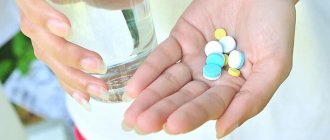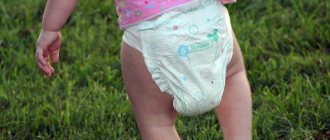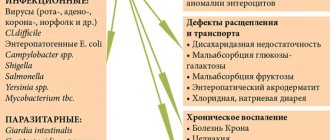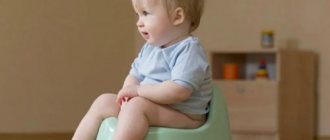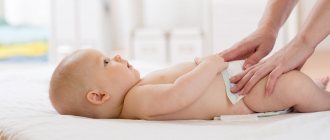Too frequent and excessively loose stools (or diarrhea) are a functional bowel disorder. Usually it is a consequence of diseases of the gastrointestinal tract of infectious, viral or parasitic origin.
Each of the mentioned pathogens is capable of infecting the tissues of various parts of the intestine, negatively affecting their absorption functions.
As a result, the body's absorption of liquids and electrolytes dissolved in them almost completely stops, and excess of these substances is urgently removed from the body, resulting in uncontrolled diarrhea.
At the same time, one can judge exactly what reason caused diarrhea in a particular case by the nature and degree of defecation disturbance.
What is considered diarrhea?
According to the World Health Organization (WHO), diarrhea is the passage of liquid stool 3 or more times a day5. In this case, you should pay special attention not only to the frequency of emptying, but also to the consistency of the stool. Frequent passage of formed feces is not considered diarrhea5, that is, with diarrhea, the stool not only becomes more frequent, it becomes more watery, liquid, and sometimes it may contain impurities (mucus, blood or undigested food particles)3,4.
Since it is not always easy to understand how shaped a stool is, experts have created a special scale - the Bristol Stool Rating Scale. It includes 7 categories that classify feces depending on their appearance1.
| Type 1 | Isolated, hard-to-pass, hard lumps similar to sheep feces |
| Type 2 | Stool in the shape of a cylinder consisting of many lumps |
| Type 3 | Feces in the shape of a cylinder, covered with striations, smaller in diameter than in the second case |
| Type 4 | Sausage-shaped feces with a smooth surface |
| Type 5 | Individual soft, shaped lumps move easily along the rectum |
| Type 6 | Fecal masses are porous, represented by unformed flakes |
| Type 7 | Stool is liquid, watery, without dense elements |
Diarrhea, according to the scale, corresponds to types 5, 6 and 73.
Why does the consistency of stool change?
The consistency of stool is determined by its water-holding capacity, i.e., the amount of unbound, “free” water4. If normally the water content in stool is 60–70%, then with diarrhea it increases to 85–95%18.
To understand why a child has loose stools, let's imagine the functioning of his digestive system. Every day, approximately 1.5-2 liters of liquid2 enter the gastrointestinal tract - this is how much we usually drink or consume in the form of liquid food. Digestive juices are added to this volume, and 4-5 times more fluid enters the small intestine than the volume of liquid that came in the form of drinks or food. Most of this fluid is absorbed in the lower small intestine, where stool formation begins. But the final “squeeze” of feces occurs in the large intestine, which, however, is capable of absorbing only 5 liters of water. Therefore, when more than five liters2 enter the colon from the small intestine, or stool moves faster9, the amount of “free” water in the stool increases9 and it becomes liquid.
We have described the mechanism of development of diarrhea2, now let’s talk about the reasons that trigger these mechanisms.
to come back to the beginning
Disease treatment process
Smecta will help with diarrhea in a child.
The process of normalizing stool largely depends on what exactly provoked the disorder, which is why determining the true cause of the disease is very important.
However, it is worth noting that there are several aspects of treatment that apply to absolutely any history of loose stool. One of these is the normalization of electrolyte balance.
The essence of this measure is to provide the child with plenty of fluids. Often, ordinary water is enough, but if bowel movements are very frequent, then it is better to purchase special solutions with a set of elements useful for the gastrointestinal tract. Among such drugs are Regidron, Glucosan and Citroglu-Cosan. In addition, if a child under 2-3 years old has loose stools, it is necessary to:
- Adjust the baby's diet. During a gastrointestinal disorder, it is important not to give your child dairy products, raw fruits, vegetables, carbonated drinks, sweets and heavy foods of any kind. The diet for the duration of therapy should consist of food that is easy for the stomach to digest: boiled rice (its decoction for very small children), soups, porridge with water - after some improvements, it is permissible to introduce lean boiled meat and eggs into the baby’s diet.
- Give your baby some medications. The baby can be helped by enterosobrents (Smecta, Enterosgel, Polysorbate), calcium gluconate, antispasmodics (Drotaverine, No-Shpa, Papaverine), carminatives (Bobotin), antipyretics (Panadol) and probiotics (Linex). Any medication can be taken only after consultation with a pediatrician or at least a pharmacist from a pharmacy. This measure is mandatory and should not be ignored.
- Naturally, if there is a factor that provokes loose stools in a baby, it is important to limit its exposure. So, for example, in case of liquid stool, which is caused by certain foods, it is better to refuse to take them, and in case of stool due to antibiotics, it is better to complete the therapeutic course, simultaneously combining it with taking special means to normalize the microflora of the gastrointestinal tract.
Causes of abdominal pain and loose stools in children
Of course, a child’s stomach does not always hurt during diarrhea, but the appearance of both symptoms at the same time may mean the presence of inflammation in the intestine17, spasm17 or overstretching of its wall13.
If a child has a stomach ache and diarrhea, the cause may be an acute intestinal infection. In children and adolescents, it is acute and is usually caused by viruses11 (rotavirus infection3, also known as “stomach flu”6) or bacteria – salmonellosis, campylobacteriosis8, dysentery2. In intestinal infections, pain is usually due to spasm of intestinal smooth muscle18.
Infectious gastroenteritis - inflammation of the stomach and small intestine - in children manifests itself with characteristic symptoms16:
- acute onset;
- increased body temperature;
- lack of appetite;
- nausea, vomiting;
- cramping abdominal pain;
- diarrhea, sometimes with false urge to defecate.
If the listed complaints appear, you should not hesitate or self-medicate - you need to consult a specialist. If infection is excluded, the doctor continues to search among non-infectious causes of abdominal pain and diarrhea in children. Unlike acute intestinal infections, these digestive disorders usually last 3 months or more and occur in a chronic form7.
We propose to analyze the most common causes of abdominal pain during diarrhea in a child, not related to exposure to viruses and bacteria.
to come back to the beginning
Irritable bowel syndrome
Children who are often anxious, have any phobias or are prone to mood swings usually complain of diarrhea and abdominal pain. If your child has a habit of suppressing emotions or has difficulty coping with psychological stress, this may affect bowel movements, causing diarrhea. At the same time, stress can lower the pain threshold15, so the child becomes more sensitive even to ordinary, non-painful irritation of the intestinal wall19. A similar condition is characteristic of irritable bowel syndrome15.
to come back to the beginning
Past acute intestinal infection (AI)
In some children, after intestinal infections, diarrhea becomes chronic4. The following factors predispose to this4:
- low body weight;
- immunodeficiency;
- a diet poor in nutrients and microelements;
- improper treatment of acute inflammation or non-compliance with medical recommendations.
If after an ACI, despite the normalization of general well-being, diarrhea continues to persist, you should consult a gastroenterologist. Ignoring painful manifestations in the future can cause serious digestive problems4.
Microflora disturbance
Dysbacteriosis (dysbiosis) is a qualitative and quantitative change in the normal composition of the intestinal microflora. In essence, this is a situation when the number of “good” microorganisms - bifidobacteria, lactobacilli and enterococci - decreases, and the number of “bad” ones, on the contrary, increases14,20.
This imbalance also develops with bacterial overgrowth syndrome (SIBO). SIBO promotes the formation of local inflammation, disrupts normal motility (motor activity) and, as a result, provokes diarrhea and abdominal pain14,20.
to come back to the beginning
Nutrition
An unbalanced diet often causes loose stools and abdominal pain7. An important role is played by the love of children and adolescents for fatty foods7, lemonade and sweetened drinks4.
Children and adolescents with food intolerances or allergies to certain foods are also prone to diarrhea and abdominal pain3. In these cases, following a strict diet allows you to normalize the functioning of the gastrointestinal tract3.
But sometimes such complaints result from parents’ attempts to provide proper nutrition. If the diet is overloaded with food that enhances motility (fresh vegetables and fruits) or triggers fermentation processes (legumes, yeast products)4, the child may experience diarrhea and pain, which is associated with overstretching of the intestinal walls and spasm of their smooth muscles17,19.
to come back to the beginning
Climate change
In some cases, when moving to a country with an unusual climate, diarrhea and abdominal pain are observed in the first 2 weeks. These are manifestations of the so-called “travelers' diarrhea”2,22.
In addition to climate change, indigestion depends on a number of factors2:
- giving up your usual diet;
- unusual mineral composition of drinking water;
- exotic dishes on the menu;
- stress from moving.
Taking certain medications
Situations where diarrhea and abdominal pain appear while taking medications require special attention. This may indicate the development of adverse reactions. In this case, you cannot adjust the treatment yourself; you need to consult a pediatrician3.
The child has diarrhea that is as thin as water
The appearance of liquid diarrhea with the consistency of water in a child indicates a disorder in his body, because diarrhea is not an independent disease. At the same time, this condition can be observed in a child not only with pathologies of the digestive organs and intestinal infections, in some cases, liquid diarrhea in a child is observed with diseases of other organs and systems of the body.
Diarrhea is more common in young children than in adults. This is due to the not yet fully formed immune system, the growth and development of the baby, the entry of a large number of microorganisms into his body, the introduction of new foods into the diet, and other reasons.
What to do if your child has diarrhea and abdominal pain
First of all, you need to consult a doctor, since the cause may be an acute intestinal infection or inflammatory diseases that require urgent treatment. If the doctor has not identified any acute illnesses, he may prescribe a diet and nutrition regimen.
To restore digestion, it is recommended2:
- eat small portions every 4 hours;
- drink enough fluids to prevent dehydration;
- give preference to dried white bread, boiled or baked vegetables and lean meat, processed cereals;
- limit the consumption of fresh vegetables, fruits, milk, fatty and fried foods.
In some cases, dietary recommendations are not enough to relieve the unpleasant symptoms of diarrhea and abdominal pain3. Then various drugs can be used3:
- solutions that replenish the lack of salts and microelements lost during diarrhea2;
- antibacterial2;
- enterosorbents that bind toxins2;
- probiotics and prebiotics for correction of intestinal microflora2;
- astringent agents2;
- enzyme preparations3;
- antidiarrheals2.
Among the antidiarrheal drugs for children over 6 years of age, the doctor can prescribe loperamide, the active ingredient in Imodium® Express®12, which helps stop diarrhea from the first use13. Imodium ® Express tablets are created using a special Zaidis technology; they do not need to be washed down - they dissolve on the tongue within a few seconds.
The drug works as follows12:
- slows down the contraction of the intestinal wall;
- increases the transit time of intestinal contents;
- increases the tone of the anal sphincter, preventing the urge to defecate;
- reduces fecal incontinence.
Imodium ® Express is indicated for diarrhea that occurs due to allergies, emotional stress, and taking medications. It also helps with traveler's diarrhea, or diarrhea caused by a change in eating habits. But for infectious diarrhea, loperamide is approved for use only as an adjuvant12.
Loose stools and abdominal pain in a child can be symptoms of many conditions and diseases. Consult your doctor to find out the cause and start treatment in a timely manner. Correcting the diet and following the pediatrician’s recommendations will help alleviate the child’s unpleasant symptoms and prevent their recurrence.
The information in this article is for reference only and does not replace professional advice from a doctor. To make a diagnosis and prescribe treatment, consult a qualified specialist.
to come back to the beginning
Water diarrhea in a child: treatment
Treatment of diarrhea with water in a child must be previously agreed with a doctor. Without his consultation, you can give your child only sorbents, drugs that slow down motor skills, and agents that restore water-salt balance. During treatment, children are usually also prescribed drugs that restore intestinal microflora. A big role is also given to nutrition and drinking plenty of fluids.
Among the folk remedies for treating diarrhea with water in children are herbal teas with mint and chamomile. Also in such cases, rice water helps a lot, drinking a third of a glass every 2-3 hours. Among other remedies for watery diarrhea, the most popular are: starch solution (a teaspoon per 100 ml of cold water), pear decoction, powder from dried films of chicken stomachs, tincture of walnut partitions, rice porridge in water without salt, and others.
Bibliography
- Features of the digestive system in children. Research methodology. Semiotics of lesions: a textbook for students / E. A. Tkachuk, N. N. Martynovich; Federal State Budgetary Educational Institution of Higher Education Institute of State Medical University of the Ministry of Health of Russia, Department of Pediatrics. – Irkutsk: IGMU, 2022. – 89 p.
- Pharmaceutical care for diarrhea. Textbook, ed. professors V.Kh.Fazylov / S.N.Egorova, T.A.Akhmetova, G.Kh.Murtazina, I.E.Kravchenko, L.N.Minapov. – Kazan, 2014. – 50 p.
- Belmer S., Gasilina T. DIARRHEA IN CHILDREN: MAIN CAUSES AND TREATMENT ROUTES. Issues of modern pediatrics. 2010;9(6):135-138.
- Pechkurov D.V., Tyazheva A.A. Chronic diarrhea in children: main causes and mechanisms, primary diagnosis, approaches to treatment. Issues of modern pediatrics. 2019; 18(6):416–423. doi: 10.15690/vsp.v18i6.2061
- Treatment of diarrhea. Training manual for doctors and other categories of senior health workers, WHO. 2006.
- Rotavirus infection. Federal Budgetary Healthcare Institution “Center for Hygienic Education of the Population” of the Federal Service for Surveillance in the Sphere of Consumer Rights Protection and Human Welfare (date of access: 10/12/2021) https://cgon.rospotrebnadzor.ru/content/63/124/
- Zakharova, I. N. Algorithm for differential diagnosis and treatment of infectious and non-infectious diarrhea in children / I. N. Zakharova, E. N. Andryukhina, Yu. A. Dmitrieva // Effective pharmacotherapy. – 2010. – No. 23. – P. 20-25.
- Kulichenko T.V. “Acute infectious diarrhea in children” Medical Council, No. 5-6, 2010, pp. 28-36.
- Bulatov V.P., Kamalova A.A. “Chronic diarrhea in children” Practical medicine, No. 7 (62), 2012, pp. 38-40.
- Kanner E.V., Gorelov A.V., Krutikhina S.B. ANTIBIOTIC ASSOCIATED DIARRHEA IN CHILDREN: A MODERN VIEW AT THE PROBLEM. Medical advice. 2017;(1):226-230.
- Subbotina Maria Dmitrievna, Kaplina Tatyana Anatolyevna Etiological structure and clinical and epidemiological features of infectious diarrhea in children // Pediatrician. 2022. No. S. URL: https://cyberleninka.ru/article/n/etiologicheskaya-struktura-i-kliniko-e... (date of access: 07/28/2021).
- Instructions for use of the drug Imodium® Express//Reg. number N016140/01//GRLS of the Russian Federation. – URL: https://grls.rosminzdrav.ru/Grls_View_v2.aspx?routingGuid=fdbc42af-4580-4ecd-93d8-2e9a965c707a&t= (access date: 10/12/2021)
- Double blind trial of loperamide for treating acute watery diarrhea in expatriates in Bangladesh.”Gut vol. 30.4 (1989): 492-
- Ardatskaya M.D., Belmer S.V., Dobritsa V.P., Zakharenko S.M., Lazebnik L.B., Minushkin O.N., Oreshko L.S., Sitkin S.I., Tkachenko E. .I., Suvorov A.N., Khavkin A.I., Shenderov B.A. “Intestinal dysbiosis (dysbacteriosis): current state of the problem, Comprehensive diagnosis and therapeutic correction” Experimental and Clinical Gastroenterology, No. 5 (117), 2015, pp. 13-50.
- Biopsychosocial Model of Irritable Bowel Syndrome. Yukari Tanaka, Motoyori Kanazawa, Shin Fukudo and Douglas A. J Neurogastroenterol Motil, Vol. 17 No. April 2, 2011, pp. 131-139
- Kovalev O. B., Molochkova O. V., Konyaev K. S., Pylaeva E. Yu., Anufrieva P. A., Kurmanova V. V., Korsunsky A. A., Kashchenko O. A., Galeeva E. V., Krylatova N.I. Etiology and clinical manifestations of acute intestinal infections in children, according to Moscow hospital data for 2016-2018 // Children's infections, T. 18, No. 2, 2022, pp. 54-57.
- Acute abdominal pain in children: educational method. allowance / Yu. K. Abaev. – Minsk: BSMU, 2007. – 96 s
- Infectious diarrhea: a problem-oriented approach in pediatrics / Children's doctor, 2010, No. 3, pp. 5-10.
- Abdominal pain and visceral hypersensitivity in patients with irritable bowel syndrome. Rome criteria IV and clinical practice / Ardatskaya M.D., Topchiy T.B. – M.: Prima-Print, 2022. – 63 p.: ill. – ISBN 978-5-9907557-9-6.
- Intestinal dysbacteriosis in children: causes, diagnosis, treatment. Educational manual / V.I. Bobrovnichiy, L.I. Vyazova. – Mn.: BSMU,
- O.Yu. Belousova Irritable bowel syndrome in children. Health of Ukraine. Pediatrics 41-43
- K.D. Ermolenko, A.M. Komarova, A.S. Drap, I.V. Razdyakonov. Travelers' diarrhea in children // Farmateka, 2016, No. 11, pp. 18-24

